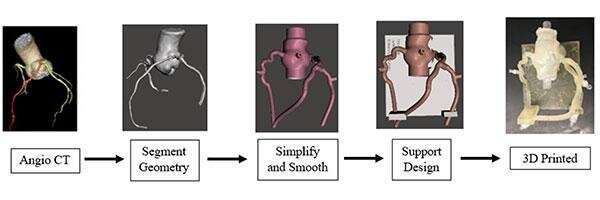Team reports advances in use of 3-D models in assessing coronary artery disease

In an article published in SPIE's Journal of Medical Imaging (JMI), researchers announce critical advances in the use of 3-D-printed coronary phantoms with diagnostic software, further developing a non-invasive diagnostic method for Coronary Artery Disease (CAD) risk assessment.
Physicians already use the non-invasive methods of Computer Tomography-Fractional Flow Reserve (CT-FFR) diagnostic software to characterize blood flow in order to assess the risk of CAD. CT-FFR uses CT images of the heart in combination with computational methods to estimate blood flow conditions in the arteries. One key shortcoming of CT-FFR lies in validating the CT-FFR diagnostic software which requires large clinical trials with ground truth. The phantom models discussed in this new paper replicate vasculature from real patients, allowing for physiological testing of actual blood flow with the provision of elastic properties, and can be used to efficiently validate CT-FFR software.
The research, delineated in the open-access article, "Initial evaluation of 3-D printed patient-specific coronary phantoms for CT-FFR software validation," demonstrates the utilization of coronary phantoms to accurately assess intermediate-risk patients' Fractional Flow Reserve (FFR), the measurement that determines CAD severity. The research also expands on the current applications of 3-D printing to further develop cardiac phantoms with structures closely mimicking patient anatomies, allowing for accurate CT imaging of coronary flow.
In this study, CT scans of these phantom cardiac models were accurate to within 1mm diameter of the actual patients' hearts, and the research team expects that accuracy to increase as the resolution of CT scanners and 3-D printers improve.
"This exceptional paper highlights an important step forward in the use of 3-D-printing of patient-specific coronary models and their contribution to assessing vasculature blood flow. It provides a critical requirement to validate the CT-FFR calculation using a phantom, thus enabling an efficient mechanism to ascertain the accuracy and reliability of CT-FFR estimation methods. This lends a strong support to the ongoing paradigm shift in CAD risk assessment via CT-FFR," says Dr. Ehsan Samei, JMI Associate Editor, SPIE Fellow, and Professor of Radiology at Duke University.
As acknowledged in the paper, this work is a continuation of research presented at the 2018 SPIE Medical Imaging conference—and published in the conference—proceedings entitled "CT investigation of patient-specific phantoms with coronary artery disease."
More information: Journal of Medical Imaging, DOI: 10.1117/1.JMI.6.2.021603 , www.spiedigitallibrary.org/jou … .JMI.6.2.021603.full

















